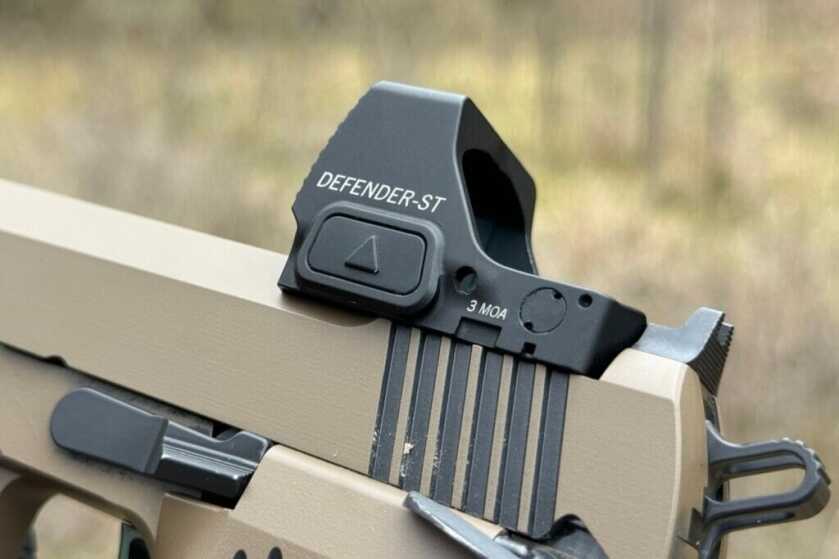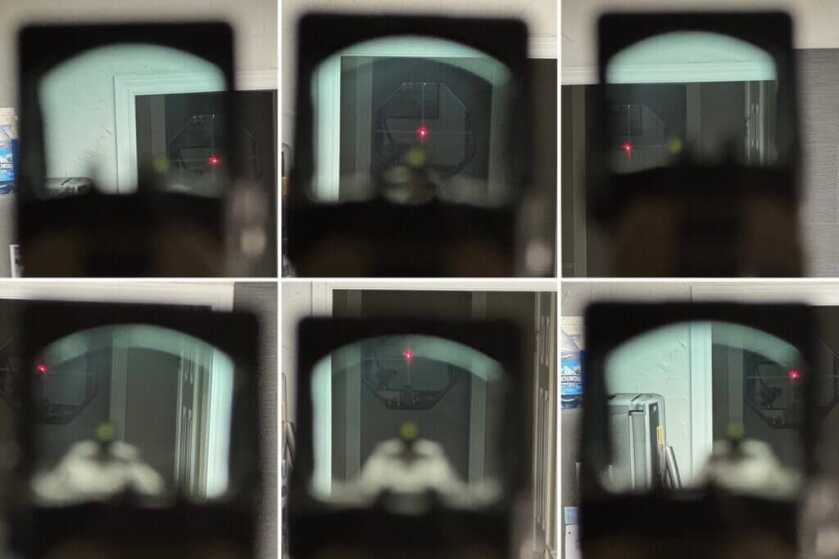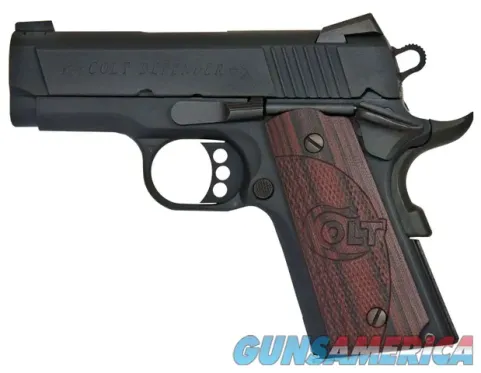
Introducing the latest innovation from Vortex Optics – the Defender-ST™ red dot pistol sight. I’ve had the privilege of testing this cutting-edge optic for about a month before its official release, allowing me to provide you with an insightful review right from the launch. The Defender-ST comes packed with features, including motion activation, a DeltaPoint Pro footprint, and a more expansive window compared to its Defender-CCW counterpart. Tailored for versatility, it’s suitable for activities ranging from turkey hunting and serving as an offset on a carbine to competitive pistol shooting. In response to user feedback on the original CCW model, the Defender-ST boasts a faster refresh rate, eliminating the pulse effect during quick target transitions and providing a competitive edge for shooters.
Vortex Defender-ST Specifications:
- Dot Size: 3 MOA, 6 MOA
- Battery Type: CR2032
- Battery Life: 25,000 hours
- Eye Relief: Unlimited
- Magnification: 1x
- Footprint: DeltaPoint® Pro
- Adjustment Graduation: 1 MOA
- Travel per Rotation: 25 MOA
- Total Elevation Adjustment: 115 MOA
- Total Windage Adjustment: 145 MOA
- Parallax Setting: Parallax Free
- Length: 1.83”
- Weight (with battery): 1.48 oz
Out of the Box
Straight out of the factory, the Defender-ST arrives well-equipped with practically everything you might require. Vortex provides a Picatinny mount, CR2032 battery, Glock MOS adapter plate, lens cloth, custom tool, and a protective cover. What’s more, a variety of fasteners are included to enable the mounting of this red dot on almost all optic-cut pistols available in the market. Vortex’s thoughtful inclusion of extra fasteners is admirable, and they’ve made it easy by labeling each bag with the fastener type and compatible pistols. This simplifies the identification of the set corresponding to whatever pistol you may be using.
SEE MORE: Vortex Defender – CCW™ Red Dot Review

Housing
The Defender-ST incorporates Vortex’s Fast-Rack™ textured face, designed to facilitate effortless slide-racking on any surface. This texturing effectively prevents the optic from slipping off smooth surfaces when pressure is applied. While the preferred method is to rack the slide conventionally with your offhand, having an optic that can endure some rough handling and assist in one-handed manipulations is incredibly useful. The glass window is slightly recessed from the housing, helping safeguard it from harm. However, the top of the glass is only recessed by 0.025″ and the bottom is recessed by 0.075″. Comparatively, the Trijicon RMR has 0.130″ of clearance at the top of the glass and 0.105″ at the bottom. While I have yet to have an issue with this, I would avoid slamming the optic against objects to rack the slide when at all possible.

At the top of the housing, Vortex has integrated a ShockShield™ polymer insert designed to absorb impacts that the optic might encounter. This serves the dual purpose of not only enhancing durability but also redistributing weight toward the bottom, reducing the torque the slide experiences during firing. Despite the Defender-ST’s weight of just 1.48 ounces, optimizing the center of gravity contributes to the overall reliability and recoil impulse of the mounted weapon system.
Battery
Powered by a CR2032 battery, the Defender-ST boasts an impressive advertised runtime of approximately 25,000 hours. This estimate is based on the dot being set to the 6th level out of 12 brightness settings. To further extend battery life, the factory default includes an auto-shutoff feature set to 10 minutes. While this feature can be disabled, when activated, the Defender-ST employs motion activation to promptly reactivate the dot upon any movement. For users with the red dot installed on a duty or concealed carry pistol, it remains consistently on due to regular movement. However, placing it in a safe or on a nightstand allows for power conservation.

Adding to its features, the Defender-ST incorporates a button lockout function designed to prevent unintentional adjustments while carrying. Accidental brightness setting adjustments may not be a common issue while concealed carrying. However, it has been a source of complaint for some users. The lockout mode can be activated by pressing and holding the up button for 3 seconds. The dot will blink off for half a second and then remain on, indicating that the brightness settings are locked and cannot be altered. To deactivate lockout mode and adjust brightness settings again, a simple 3-second press of the up button does the trick. This results in the dot blinking off twice in 1 second, confirming that lockout mode has been disabled.
Buttons
The Defender-ST places brightness adjustment controls on both the left and right sides of the housing. The up arrow increases brightness, while the down arrow decreases it. Vortex has crafted a raised lip on the housing, aligning with the button tops to prevent unintentional changes. The adjustments provide tactile and audible feedback. With a total of 12 brightness settings, including 10 for daylight conditions and 2 for use with night vision. This red dot is definitely daylight-bright and gets brighter than the Trijicon RMR when on its highest setting. On the other end of the spectrum, the night vision settings work great as well.

Turrets
For zero adjustments on this optic, Vortex employs an elevation turret located on the top of the housing and a windage turret positioned on the right side. Adjusting for the bullet’s point of impact is a simple twist of these turrets. If the initial impact is high and to the right, dial the adjustments down and to the left accordingly. Each click on the turrets corresponds to a 1 MOA movement in the bullet’s point of impact. This means it will take 10 clicks at 10 yards to move the POI one inch. These adjustments represent an improvement over previous Vortex red dots, offering both audible and tactile feedback. While there’s a slight play between adjustments, there is a distinct click with each adjustment. The clicks provide an audible and tactile indication.

Glass
The window for the Defender-ST is noticeably larger than that of the Defender-CCW. It utilizes the DeltaPoint Pro footprint, which gives the body a larger overall size as well. The large hard coated aspherical lens offers a “distortion-free sight picture.” While the Defender-ST is lightyears better than a Trijicon RMR, it does have the slightest amount of refraction noticeable when moving the optic from side to side. In addition to this, the glass offers much truer colors with only a very faint blue tint. To help show how it compares to other optics on the market I made the image below. Pay no attention to the size of the optic as some were closer in the picture than others, the clarity is what I am aiming to show.

Testing
One thing I wanted to test with the Defender-ST is how well the dot shifted despite where the user had the dot placed in the window. Some red dots can have a large POI shift (a foot or so at 20 yards) when the dot is zeroed when shot at the bottom of the window but then used at the top. However, the Defender-ST proved to track great. I set it up in a tripod aiming at an intersection point in my window, and took pictures from different angles. Each picture shows the dot still aiming at the same point which is a great accomplishment.

Another solid update is the quicker refresh rate. Vortex received criticism on their previous red dots for using a red dot that had a visible refresh rate. When looking through it when stationary this was hard to tell, but when looking at it when waving the red dot from side to side you could see it pulsing. This is no longer the case with the Defender-ST. The dot always appears solid and crisp. Cheers to Vortex for listening to what the consumers were demanding.
Durability
While I have only had this red dot for a little over a month, I have been able to put around 550 rounds downrange with it mounted to 9mm pistols. I never had any sort of issue come up throughout my testing. The Vortex Defender-ST held zero and ran flawlessly even after a few table racks where I was testing out the Fast-Rack™ front face.
The clear glass helped with target focus, and the large window allowed for a cleaner field of view. I was even able to use it on a 45-degree offset mount on an AR and was able to shoot a 12″ steel target at 300 yards. With the crisp 3-MOA dot I had, I was also able to shoot it out to 150 yards when mounted on a pistol. I posted a short video to my Instagram page below, using the Defender-ST mounted to a Stealth Arms Platypus:
In addition to the aforementioned shooting experiences, I had the opportunity to participate in a pistol course at the Vortex Edge shooting facility this past December. During this course, all participants, including myself, used the yet-to-be-released Defender-ST with the Vortex MOS plate mounted to Glocks. Collectively, we fired over 2,000 rounds through these pistols without encountering any issues with the Defender-ST. As a testament to its competition-grade window, I successfully completed three Bill Drills – drawing and firing six rounds at a silhouette on the buzzer, from distances of 7, 15, and 25 yards. The total time for these three drills was 9.8 seconds, earning an 8.36 hit factor. Personally, I was quite happy with this score, and I believe that the Defender-ST provided me with a competitive advantage over the RMR I am used to and which I have mounted to my personal carry gun.

Summary
I think the new Vortex Defender-ST is proving to be a solid option for everything from EDC to competition shooting. This red dot has an MSRP of $469.99 and should have a street price of around $330. It also comes with a Picatinny mount right from the factory. The red dot utilizes the common DeltaPoint Pro footprint and features a large clear window contained in a rugged housing. Add in a top-loading battery, tactile adjustments, a unique front Fast-Rack™ front face, and good durability, this is a solid-performing optic at a competitive price.
*** Buy and Sell on GunsAmerica! ***












The iron sights you have on the Stealth Arms Platypus, are they the Standard or the High iron sights and how did they co-witness in the Vortex Defender ST?
Country of origin?